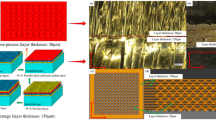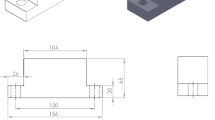Abstract
In this work, a single point incremental forming method was applied using both a roller-ball tool and a standard forming tool with oil application. Aluminium AA1050 sheet with 0.8-mm thickness was used as the experiment material. The experiments were applied according to Taguchi L18 experimental design. Surface roughness measurements and thickness distributions were evaluated in terms of tool type, amount of the stepdown and the wall angles. ANOVA and regression analysis were also performed to show the influence of the process parameters on the surface roughness measurements. According to results, roller-ball tool with a wall angle of 40° and stepdown amount of 0.25-mm yielded the lowest surface roughness as 1.389-µm for Ra and 7.433-µm for Rz. Compared to the standard forming tool, the roller-ball tool performed better both surface roughness and thickness distribution results. However, the most effective parameter was found to be the wall angles in relation to the surface roughness. FEM analysis was made for thickness distributions with the same process conditions for each tool type. The actual measurements for thickness distribution were similar to the results obtained from FEM analysis.














Similar content being viewed by others
References
Lu H B, Le Li Y, Band Liu Z, Liu S and Meehan P A 2014 Study on step depth for part accuracy improvement in incremental sheet forming process. Adv. Mater. Res. 939(3): 274–280
Hino R, Yoshida F, Nagaishi N and Naka T 2008 Incremental sheet forming with local heating for lightweight hard-to-form material. Int. J. Mod. Phys. B 22(31–32): 6082–6087
Chang Z and Chen J 2020 Mechanism of the twisting in incremental sheet forming process. J. Mater. Process. Technol. 276(6): 1–7
Maji K, Chakraborty S S, Pratihar D K and Nath A K 2020 Inverse analysis and multi-objective optimization of coupling mechanism based laser forming process. Sadhana: Acad. Proc. Eng. Sci. 45(1): 1–16
Jawale K, Duarte J F, Reis A and Silva M B 2018 Microstructural investigation and lubrication study for single point incremental forming of copper. Int. J. Solids Struct. 151: 145–151
Ganesh P, Visagan A, Ethiraj N, Prabhahar M and Sendilvelan S 2020 Optimization of pyramid shaped single point incremental forming of AA5052 alloy sheet. Mater. Today Proc. 45(7): 5892–5898
Yang Z and Chen F 2020 Mechanism of twist in incremental sheet forming of thermoplastic polymer. Mater. Des. 195: 1–11
Oraon M and Sharma V 2020 Measurement of electromagnetic radiation in the single point incremental forming of AA3003-O. Int. J. Light. Mater. Manuf. 3(2): 113–119
Kumar A and Gulati V 2018 Experimental investigations and optimization of forming force in incremental sheet forming. Sadhana: Acad. Proc. Eng. Sci. 43(10): 1–15
Singh A and Agrawal A 2017 Experimental force modeling for deformation machining stretching mode for aluminum alloys. Sadhana: Acad. Proc. Eng. Sci. 42(2): 271–280
Liu F, Li X, Li Y, Wang Z, Zhai W, Li F and Li J 2020 Modelling of the effects of process parameters on energy consumption for incremental sheet forming process. J. Clean. Prod. 250: 1–17
McAnulty T, Jeswiet J and Doolan M 2017 Formability in single point incremental forming: a comparative analysis of the state of the art. CIRP J. Manuf. Sci. Technol. 16: 43–54
Guha S 2022 Investigation of the mechanical response of a micro-textured surface using a higher order strain gradient plasticity theory. Sadhana: Acad. Proc. Eng. Sci. 47(137): 1–17
Wang Z, Cai S and Chen J 2020 Experimental investigations on friction stir assisted single point incremental forming of low-ductility aluminum alloy sheet for higher formability with reasonable surface quality. J. Mater. Process. Technol. 277: 1–9
Chang Z, Yang M and Chen J 2021 Experimental investigations on deformation characteristics in microstructure level during incremental forming of AA5052 sheet. J. Mater. Process. Technol. 291: 1–9
Shrivastava P and Tandon P 2019 Microstructure and texture based analysis of forming behavior and deformation mechanism of AA1050 sheet during single point incremental forming. J. Mater. Process. Technol. 266: 292–310
Lu B, Fang Y, Xu D K, Chen J, Ou H, Moser N H and Cao J 2014 Mechanism investigation of friction-related effects in single point incremental forming using a developed oblique roller-ball tool. Int. J. Mach. Tools Manuf. 85: 14–29
Fan G, Gao L, Hussain G and Wu Z 2008 Electric hot incremental forming: a novel technique. Int. J. Mach. Tools Manuf. 48(15): 1688–1692
Liu Z B, Le Li Y, Daniel B and Meehan P 2014 Taguchi optimization of process parameters for forming time in incremental sheet forming process. Mater. Sci. Forum 773–774: 137–143
Naranjo J, Miguel V, Martínez-Martínez A, Gómez-López L M, Manjabacas M C and Coello J 2015 Analysis and simulation of single point incremental forming by ANSYS®. Proc. Eng. 132: 1104–1111
Erkan Ö, Sur G and Nas E 2020 Investıgatıon of surface morphology of drilled CFRP plates and optimization of cutting parameters. Surf. Rev. Lett. 27(9): 1–8
Lasunon O U 2013 Surface roughness in incremental sheet metal forming of AA5052. Adv. Mater. Res. 753–755: 203–206
Maqbool F and Bambach M 2018 Dominant deformation mechanisms in single point incremental forming (SPIF) and their effect on geometrical accuracy. Int. J. Mech. Sci. 136(2018): 279–292
Seyyedi S E, Gorji H, Bakhshi-Jooybari M and Mirnia M J 2023 Comparison between conventional press-working and incremental forming in hole-flanging of AA6061-T6 sheets using a ductile fracture model. Int. J. Solids Struct. 270(June 2022): 1–14
Prakash Singh R, Kumar Gupta S, Kumar Singh P and Kumar S 2021 Robot assisted incremental sheet forming of Al6061 under static pressure: preliminary study of thickness distribution within the deformation region. Mater. Today Proc. 47: 2737–2741
Chen T C 2007 An analysis of forming limit in the elliptic hole-flanging process of sheet metal. J. Mater. Process. Technol. 192–193: 373–380
He S, Van Bael A, van Houtte P, Duflou J R, Szekeres A, Henrard C and Habraken A M 2005 Finite element modeling of incremental forming of aluminum sheets. Adv. Mater. Res. 6–8: 525–532
Esmaeilpour R, Pourboghrat F, Kim H and Park T 2019 Finite element analysis of single point incremental forming (SPIF) of aluminum 7075 using different types of toolpath. IOP Conf. Ser. Mater. Sci. Eng. 521(1): 1–6
Author information
Authors and Affiliations
Contributions
Dr. MÇ was responsible for methodology and supervision. ÖÇ was responsible for experimental procedures and FEM analyses, methodology and review. Dr. FÖ was responsible for methodology, experimental procedures, conceptualization, optimizations, editing and preparation of the draft.
Corresponding author
Rights and permissions
Springer Nature or its licensor (e.g. a society or other partner) holds exclusive rights to this article under a publishing agreement with the author(s) or other rightsholder(s); author self-archiving of the accepted manuscript version of this article is solely governed by the terms of such publishing agreement and applicable law.
About this article
Cite this article
Çalişkan, M., Çerlek, Ö. & Özen, F. A comparative study: incremental sheet forming of AA1050 by roller-ball tool and standard tool with its optimization. Sādhanā 49, 78 (2024). https://doi.org/10.1007/s12046-023-02420-9
Received:
Revised:
Accepted:
Published:
DOI: https://doi.org/10.1007/s12046-023-02420-9




